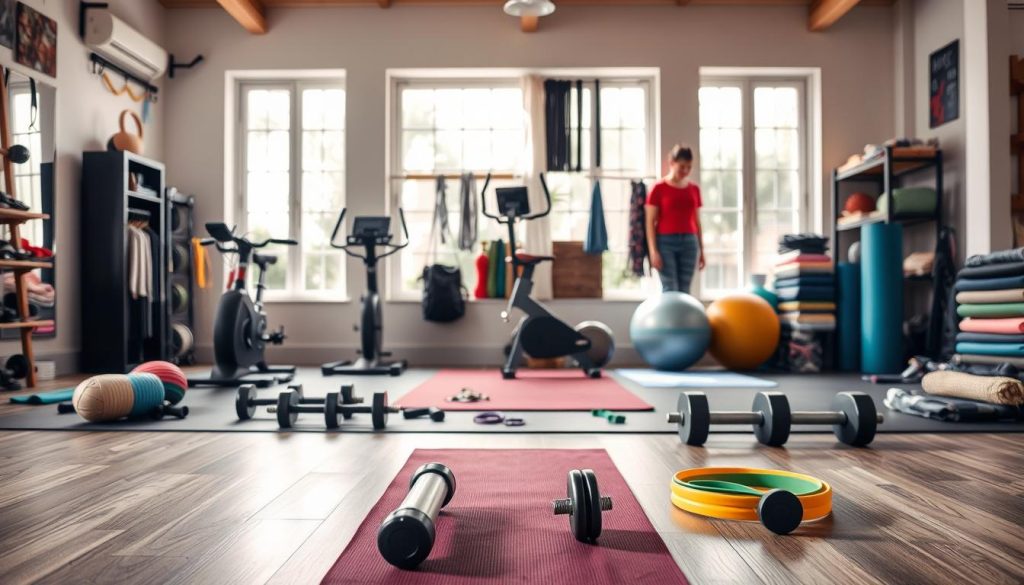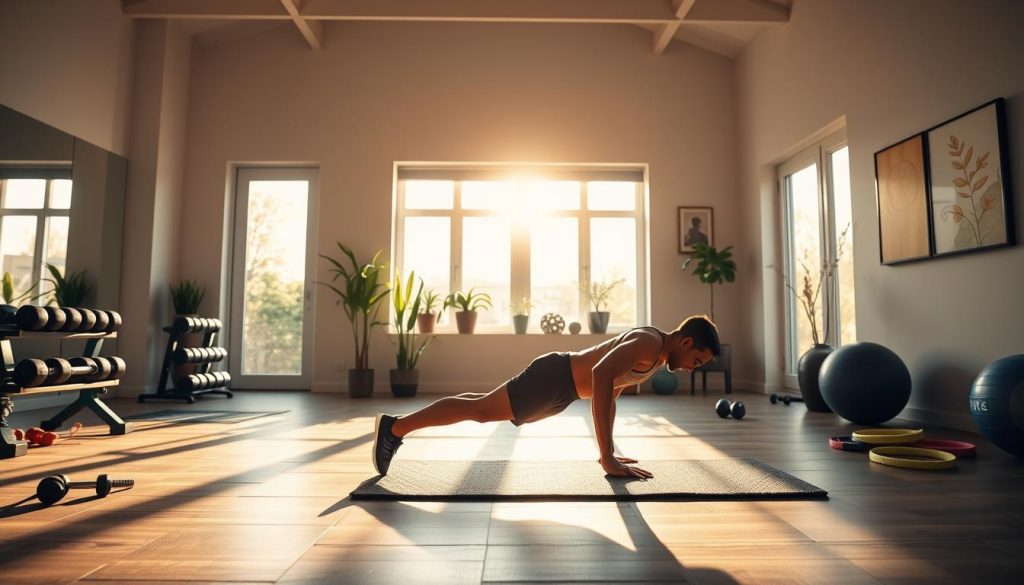Staying fit doesn’t require a gym membership or expensive equipment. With the right plan, you can achieve your fitness goals from the comfort of your living room. Whether you’re a beginner or looking for a new challenge, there’s a routine for everyone.
This guide covers a variety of bodyweight exercises and programs designed to build strength and endurance. From warm-up sequences to advanced techniques, you’ll find everything you need to stay active. Plus, free resources like downloadable PDFs make it easy to follow along.
Fitness should be fun and accessible. With these tips, you can create a routine that fits your schedule and keeps you motivated. Let’s get started!
Key Takeaways
- No gym or equipment is needed to stay fit.
- Exercises are suitable for all fitness levels.
- Free resources like PDFs are available for guidance.
- Routines can be customized to fit your schedule.
- Focus on building strength and endurance safely.
Getting Started with At-Home Fitness
Starting your fitness journey doesn’t have to be complicated or intimidating. With the right plan, you can build a routine that fits your lifestyle and helps you stay consistent. The first step? A proper warm-up to prepare your body for action.
The Importance of a Proper Warm-Up
A good warm-up is essential to activate your muscles and prevent injuries. It increases blood flow, improves flexibility, and gets you mentally ready for your session. Simple movements like marching in place, arm swings, and leg swings are great for beginners.
For a more dynamic approach, try jumping jacks or a quick jump rope session. These exercises elevate your heart rate and prepare your body for more intense activities. As NF Senior Coach Staci advises, “Spend at least 5 minutes on your warm-up to ensure your body is ready for the challenge.”
Easy Starter Routines to Get You Moving
If you’re new to fitness, start with simple exercises like assisted squats and countertop push-ups. These movements are beginner-friendly and can be modified to suit your fitness level. For example, use a sturdy chair for support during squats or reduce the range of motion for push-ups.
Gradually increase repetitions as you build strength and confidence. A routine of 2-3 sets per exercise is a great way to start. Remember, consistency is key—even 10 minutes a day can make a difference.
“Progress doesn’t happen overnight, but every small step counts.”
For additional guidance, check out video tutorials that demonstrate both basic and advanced warm-up techniques. These resources can help you stay on track and ensure you’re performing each movement correctly. With the right approach, you’ll be ready to tackle more challenging exercises in no time.
Bodyweight Basics for All Fitness Levels
Bodyweight exercises are a versatile way to build strength and endurance without equipment. Whether you’re a beginner or looking for a new challenge, these techniques can be tailored to your fitness level. The best part? You can do them anywhere, anytime.
Beginner Bodyweight Techniques
If you’re new to fitness, start with simple movements like squats and modified push-ups. These exercises are easy to learn and can be adjusted to match your ability. For example, use a chair for support during squats or perform push-ups on your knees.
Here’s a basic routine to get you started:
- Squats: 2 sets of 10 reps
- Modified Push-Ups: 2 sets of 8 reps
- Plank: Hold for 20 seconds
As you build confidence, gradually increase the number of reps or sets. Consistency is key—even 10 minutes a day can make a difference.
Advanced Movements and Variations
Ready to take it up a notch? Advanced bodyweight exercises like one-legged squats and pull-ups can push your limits. These movements require more control and balance, making them perfect for those seeking a challenge.
Here’s an advanced routine to try:
- One-Legged Squats: 3 sets of 8 reps per leg
- Pull-Ups: 3 sets of 5 reps
- Mountain Climbers: 30 seconds per set
Focus on proper form to avoid injury. For example, keep your core engaged during one-legged squats and maintain a steady pace during pull-ups.
| Exercise | Sets | Reps/Time |
|---|---|---|
| Squats | 2 | 10 |
| Modified Push-Ups | 2 | 8 |
| Plank | 1 | 20 seconds |
| One-Legged Squats | 3 | 8 per leg |
| Pull-Ups | 3 | 5 |
| Mountain Climbers | 3 | 30 seconds |
For those who prefer a structured approach, downloadable PDFs and video tutorials are available. These resources can help you track progress and ensure proper form. Remember, the goal is gradual improvement—small steps lead to big results.
Exploring Diverse Home Workout Programs
Transform your living space into a fitness hub with diverse training styles. From high-intensity sessions to creative themes, there’s something for everyone. Whether you’re a beginner or seeking a new challenge, these programs keep you motivated and engaged.

Circuit Training and HIIT Workouts
Circuit training and HIIT are excellent options for maximizing results in minimal time. These programs combine strength and cardio, making them ideal for busy schedules. For example, a typical HIIT session includes 30 seconds of intense activity followed by 10 seconds of rest.
Benefits of these routines include improved endurance, fat burning, and time efficiency. A well-structured plan ensures you stay consistent and see progress. For visual learners, video tutorials and downloadable PDFs are available to guide you.
Themed Routines: Star Wars, Angry Birds & More
Inject fun into your routine with themed workouts. Imagine channeling your inner Jedi with Star Wars-inspired exercises or jumping like an Angry Bird. These creative options make fitness enjoyable and engaging.
Themed routines are perfect for breaking monotony and keeping you excited about your plan. They also cater to different fitness levels, allowing you to customize the intensity. As one fitness enthusiast shared, “Themed workouts turned exercise into a game I look forward to every day.”
Designing a Flexible Home Training Plan
Creating a flexible plan is key to long-term success. Start by assessing your fitness level and available equipment. Incorporate a mix of strength training and cardio to ensure a balanced approach.
Gradually increase the difficulty by adding extra sets or trying advanced variations. For example, swap regular squats for one-legged squats or increase the duration of your planks. A well-designed routine adapts to your progress and keeps you challenged.
For added convenience, explore video guides and downloadable PDFs to track your journey. Remember, the goal is to stay consistent and enjoy the process. With the right plan, you’ll achieve your fitness goals while having fun.
Optimizing Your “Workout at Home Free” Routine
Fine-tuning your daily exercise plan can lead to better results and more consistency. A well-structured program ensures you stay on track while adapting to your evolving needs. Whether you’re a beginner or looking for a new challenge, these tips will help you maximize your efforts.
Structuring Your Daily Program
Start by setting clear goals for each day. A balanced routine might include strength training, cardio, and flexibility exercises. For example, dedicate 20 minutes to bodyweight exercises, 10 minutes to HIIT, and 5 minutes to stretching.
Tracking your progress is essential. Use downloadable PDFs or apps to log your sets, reps, and time. This helps you identify patterns and areas for improvement. As one fitness expert noted, “Consistency is the foundation of progress.”
Incorporating Progressive Challenges
Gradually increase the difficulty of your exercises to keep your body challenged. For instance, add an extra set or reduce rest time between intervals. Advanced options like one-legged squats or pull-ups can also push your limits.
Here’s a sample progression for a strength training routine:
- Week 1: 2 sets of 10 squats
- Week 2: 3 sets of 12 squats
- Week 3: Add a 10-second hold at the bottom of each squat
Mixing up your routine prevents boredom and plateaus. Try new exercises or switch between HIIT and steady-state cardio. The key is to keep it engaging and aligned with your goals.
“Small, consistent changes lead to lasting results.”
Finally, adapt your plan to fit your lifestyle. If you’re working home, schedule short breaks for movement. Remember, fitness is a journey—celebrate every step forward.
Building Muscle and Losing Weight at Home
Building muscle and losing weight can be done effectively from your living room. With the right plan, you can achieve your fitness goals without stepping foot in a gym. Focus on strength training and progressive overload to see real results.
Strength Training and Progressive Overload
Strength training is the foundation of muscle growth. Start with basic exercises like squats, push-ups, and planks. Gradually increase the difficulty by adding more sets or reps. This approach, known as progressive overload, ensures your muscles are constantly challenged.
For example, if you’re doing bodyweight squats, increase from 2 sets of 10 to 3 sets of 12 over a few weeks. You can also modify exercises to make them harder, like switching to one-legged squats. Proper form is key to avoiding injury and maximizing results.
Nutrition and Lifestyle Adjustments
Nutrition plays a crucial role in muscle building and weight loss. Focus on a balanced diet rich in protein, healthy fats, and complex carbs. As Jimmy from Nerd Fitness shared, “Eating right is just as important as lifting weights.” Meal planning can help you stay on track.
Lifestyle adjustments, like staying hydrated and getting enough sleep, also matter. Aim for 7-8 hours of rest each night to support recovery. Small changes, like swapping sugary snacks for nuts or fruit, can make a big difference over time.
| Exercise | Sets | Reps/Time |
|---|---|---|
| Squats | 3 | 12 |
| Push-Ups | 3 | 10 |
| Plank | 2 | 30 seconds |
| One-Legged Squats | 3 | 8 per leg |
For structured guidance, explore video tutorials and downloadable PDFs. These resources can help you track progress and stay motivated. Remember, consistency is the key to long-term success.
“Small, consistent changes lead to lasting results.”
With the right program and mindset, you can achieve your fitness goals. Start today and embrace the journey to a stronger, healthier you.
Final Thoughts: Embrace Your Personal Fitness Journey
Your fitness journey is unique, and every step forward is a victory. Whether you’re following a structured program or creating your own plan, consistency is key. Celebrate each day you dedicate to your health and well-being.
Embrace new challenges to keep your training exciting. From HIIT sessions to strength exercises, there’s always room to grow. Use resources like PDFs and videos to guide your progress and stay motivated.
Remember, fitness is a journey, not a race. Small improvements over time lead to lasting results. Stay strong, stay focused, and make fitness a rewarding part of your lifestyle.
FAQ
Why is warming up important before starting a fitness routine?
Warming up prepares your body for exercise by increasing blood flow, loosening muscles, and reducing the risk of injury. It’s a key step for any fitness plan, even at home.
What are some easy starter routines for beginners?
Simple routines like squats, push-ups, and planks are great for beginners. These bodyweight exercises build strength and don’t require equipment.
How can I progress from beginner to advanced bodyweight exercises?
Start with basic movements and gradually add variations like jump squats or one-arm push-ups. Consistency and progressive challenges help you level up.
What’s the benefit of circuit training or HIIT workouts?
Circuit training and HIIT are efficient, combining strength and cardio in short bursts. They’re perfect for burning calories and improving fitness in limited time.
Can themed routines like Star Wars or Angry Birds make fitness fun?
Absolutely! Themed routines add creativity and motivation to your training plan, making it enjoyable while keeping you active.
How do I structure a flexible home training program?
Focus on variety and balance. Mix strength training, cardio, and rest days. Adjust your plan weekly to match your goals and schedule.
What’s the best way to build muscle at home without weights?
Use progressive overload by increasing reps, slowing movements, or trying harder variations. Pair this with proper nutrition for muscle growth.
How does nutrition support my fitness journey?
Eating balanced meals with protein, carbs, and healthy fats fuels your body. Proper nutrition enhances energy, recovery, and overall results.



